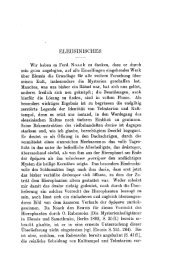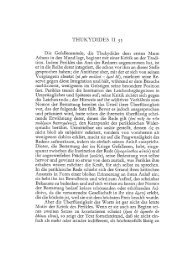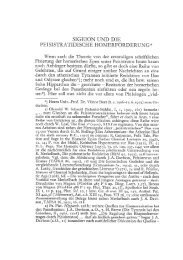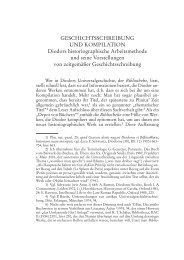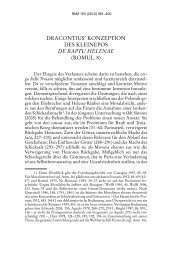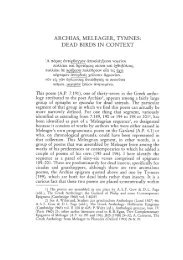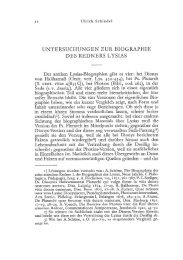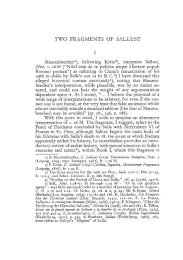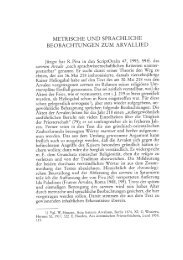APOTELESMATICA 2. (1) 14–140: SOURCES AND MODELS*
APOTELESMATICA 2. (1) 14–140: SOURCES AND MODELS*
APOTELESMATICA 2. (1) 14–140: SOURCES AND MODELS*
Create successful ePaper yourself
Turn your PDF publications into a flip-book with our unique Google optimized e-Paper software.
82 Maria Ypsilanti<br />
not take up much of the Dog, only the space the Dog occupies with its<br />
feet. On it are the Argo and the Centaur’s great back, on it is the Scorpion’s<br />
sting, on it the bow of the brilliant Archer.<br />
Pseudo-Manetho agrees with Aratus in that he omits the Beast,<br />
included by Eudoxus (fr. 73,13) in his description of the stars of<br />
the tropic, a passage criticised by Hipparchus, as the Beast is<br />
south of the tropic: poll“ går noti≈terÒn §sti tÚ Yhr¤on toË<br />
xeimerinoË tropikoË, Hipp. 1.10,17. The Waterpourer’s knees are<br />
mentioned only by Germanicus 486 who possibly describes a figure<br />
on the globe of the Atlas Farnese or a sketch similar to it. 30<br />
Pseudo-Manetho is also very probably inspired by an analogous<br />
figure. Similar observations can be made about the description of<br />
the stars of Argo. The author agrees with Eudoxus who speaks of<br />
ka‹ t∞w ÉArgoËw ≤ prÊmna ka‹ ı flstÒw (fr. 73,12), with his poetically<br />
elaborated image, ll. 97–8 ±d¢ ka‹ ÉArgoËw / pontopÒrou . . . êkra<br />
kÒrumba. 31 As probably happens with the janyØn tÉ aÈxen¤hn<br />
xa¤thn xaropo›o L°ontow and the description of the Bird,<br />
Ophiouchus and the Twins in the tropic of Cancer, this vivid<br />
image presumably indicates an artistic representation of the ship<br />
on a globe the author has in front of him. The River, included by<br />
Eudoxus (fr. 73,4) and not commented upon by Hipparchus, is<br />
omitted both by Aratus and Pseudo-Manetho. Pseudo-Manetho,<br />
however, like Eudoxus and Aratus, includes the Scorpion’s sting<br />
in the stars of the tropic, a choice with which Hipparchus<br />
(1.10,16) disagrees. 32<br />
30) See le Bœuffle (1975) 31 n. <strong>2.</strong><br />
31) This precision is also found in Germanicus 489 sacrae speciosa aplustria<br />
Puppis, Hyginus 4.4 navis ipsius puppim, Planudes (b l. 5 f.) e‰ta dÉ ékrostÒliÒn te<br />
ka‹ flst¤on ÉArgÒow êkron / sx¤zei. The depiction of Argo on the globe Farnese is impressive<br />
indeed and probably gives us a characteristic example of the ship’s artistic<br />
representations on globes; Germanicus’ expression further reinforces the assumption<br />
that he did have a globe in front of him, probably a similar one to the globe<br />
Farnese. Cf. the analogous implications of Manilius’ elaborated expression about<br />
the Horse (1.4,348) and other constellations, see Thiele 47. Planudes and the globe<br />
of Ptolemy include in the tropic of Capricorn the Capricorn, the middle of the<br />
Waterpourer, the tail of the sea-Monster, the front foot of the Hare, the middle of<br />
the Dog, the stem-post ornaments and the extremity of the sail of Argo, a part of<br />
Corax, the edge of Hydra’s tail, Antaris, a star of Scorpio, the Archer’s head.<br />
32) Cf. Kidd on Arat. 501–510 and 505. In general the description of the constellations<br />
of this tropic here is not far from their depiction on the globe Farnese,<br />
with the exception of the description of the parts of Argo, as on the globe Farnese



